At the end of the day, we have plenty of options to get the job done. Grab a bar and some plates and you could accomplish most of your fitness-related goals. Grab a kettlebell and start swinging and you’ll see improvements. Or simply take yourself to the local park for sprints, pushups and pull-ups, and you’d be doing more than most.
One tool that has passed the test and is now a staple in my fitness toolbox is the heavy rope. Over the past couple years, they have increased in popularity and are now found in fitness facilities on a more consistent basis. Can you get a complete workout in with just the rope? Absolutely. All you need is your body, a little room and some motivation, and you’ll be good to go. With a little instruction, the addition of heavy ropes will challenge clients in safe, new ways and help them achieve their goals.
For many of my clients, I recommend full-body routines a few times a week. Couple that with some sprints and a diet of REAL food, and you are on your way to a healthier lifestyle. If it’s just you and your rope, you’ve got everything you need. I would recommend hitting a few of the major movement pillars (i.e., push, pull, level change, etc.) in your routine to ensure a balanced full-body approach.
Here is a simple template to get you started. Set up three stations as follows: Start with a rope movement, then perform a bodyweight movement and then finish with a second rope movement.
Circuit 1
Station 1: Rope: Double Rope Slams - 20 reps
Station 2: Bodyweight: Skater Plyos (lateral jumps) - 20 reps (10 per leg)
Station 3: Rope: Rope Inverted Rows - 15 reps
Repeat this routine three times with little rest and then rest for two to three minutes before starting circuit #2.
Circuit 2
Station 1: Rope: Reverse Lunge Waves - 10 lunges per leg
Station 2: Bodyweight: Push-ups - 10 reps (add a clap if too easy)
Station 3: Rope: Vertical Rope Pulls - 2 lengths of the rope
Repeat this routine three times with little rest and then rest for two to three minutes before starting circuit #3.
Circuit 3
Station 1:Rope: Grappler Slams - 20 total (10 per side)
Station 2: Bodyweight: Squats - 15 reps
Station 3: Rope: Plank Rope Pulls - 20 total (10 pulls per arm)
Repeat this routine three times with little rest between stations.
Looking at the movements, you’ll see that we hit all three planes of motion, upper-body pushing and pulling, lower-body variations, and movements that challenge both your strength and conditioning to ensure a well-rounded workout.
EXERCISE DESCRIPTIONS
Circuit 1Double Rope Slams
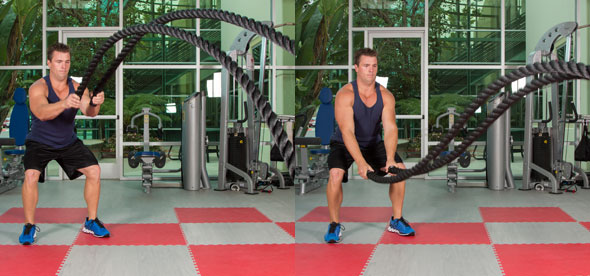
Begin facing the anchor point in an athletic position while holding an end of the rope in each hand. Lift the ropes up and explosively drive them down into the ground. Be sure to use the entire body when performing the movement. Do not just “arm” the exercise. Maintain a neutral spine throughout and bend the hips and knees while slamming the rope.
Skater Plyos (lateral jumps)
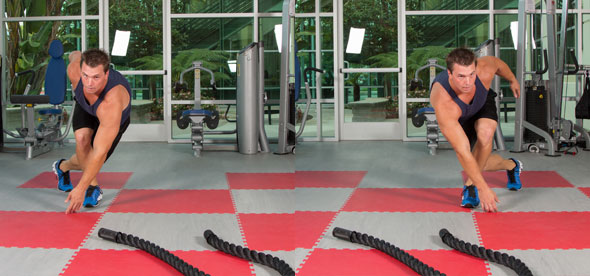
Begin by pushing off your left leg and jumping laterally to the right. Land softly under control on your right leg while the left hand reaches toward the ground in front of the right leg. Next, push off the right leg to jump back to the left (starting position). Land on the left leg while the right hand reaches out in front of the left leg. Continue this side-to-side movement for the appropriate number of reps.
Rope Inverted Rows
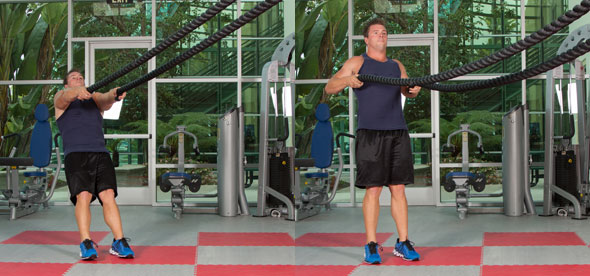
This movement is very similar to an inverted row exercise you’d do with a suspension trainer (TRX for example). Hang the rope over a vertical anchor (tree branch or pull-up bar) and face the anchor point. Walk your feet down toward the anchor point so your body is angled about 45 degrees from the floor. Keep your eyes on the anchor point and begin by flexing at the elbows and pulling your body up. Be sure to keep your shoulders down and back the entire time. Once your hands are just about in line with your chest, slowly extend your arms to return to the starting position.
Circuit 2
Reverse Lunge Waves
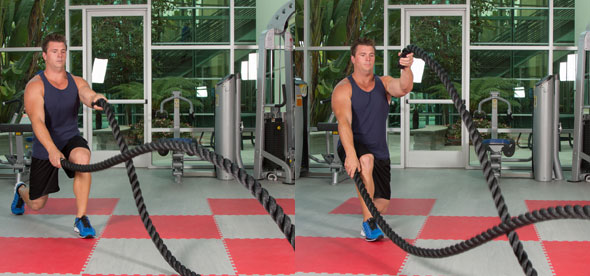
Face the anchor point in an athletic position while holding an end of the rope in each hand. Begin by creating “waves” with the rope by alternating your arms in a quick up-and-down wave or drumming fashion. While performing this wave movement with your arms, do alternating reverse lunges with your lower body at the same time. Maintain a neutral spine and keep your eyes on the anchor point throughout the movement.
Push-ups
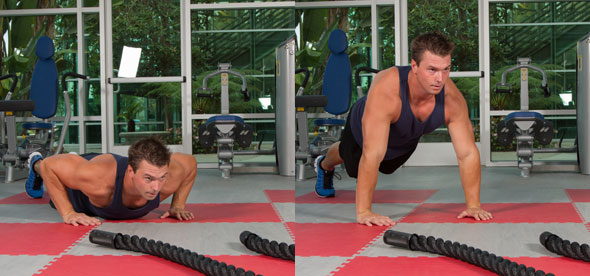
Begin in a traditional pushup position with your hands slightly wider than shoulder width and your elbows at a 45-degree angle from your body. Lower your entire body down under control and then push back up to the starting position. Maintain a neutral spine and keep your body engaged throughout the exercise to ensure proper form.
Vertical Rope Pulls
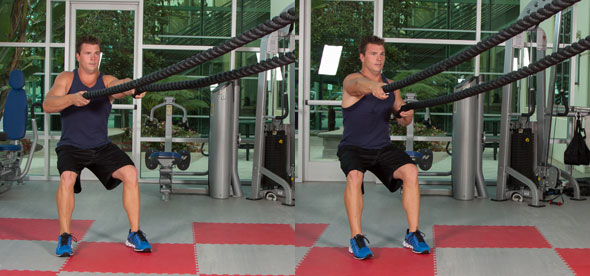
With the rope secured around a vertical anchor (tree branch, pull-up bar, etc.), assume an athletic position and begin by reaching up with one arm and pulling the rope toward the body. Alternate these vertical pulls for the desired number of reps.
Circuit 3
Grappler Slams
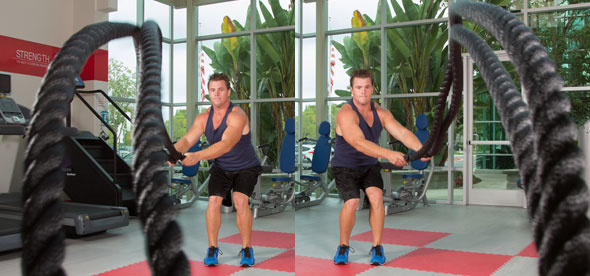
Face the anchor point in an athletic position while holding an end of the rope in each hand. Begin by lifting the ropes up, rotating your shoulders and hips right, and slamming the ropes down on the right side of your body. As you lift them back up, rotate your body left, creating an arc pattern with the rope, and slam them down on the left side. Continue this rotating pattern for the appropriate number of reps.
Squats
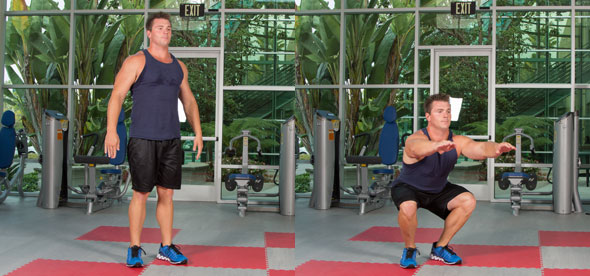
Take a slightly wider than shoulder-width foot position, with your toes pointed out slightly. Upon descent, keep your chest up, abs braced and push your butt back as you think about opening your knees. Keep your head position neutral (eyes looking forward) throughout the movement. Squat down as low as you can without breaking form (no lumbar flexion) and then return to the starting position by driving your hips through and standing up tall.
Plank Rope Pulls
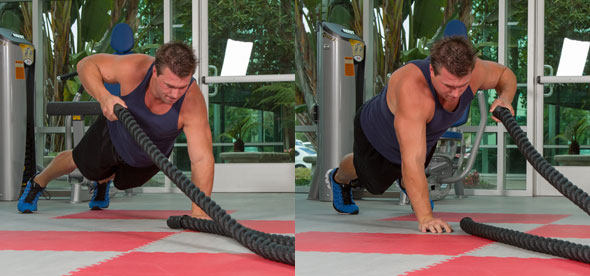
Assume a plank position facing the anchor point, extend one arm and pull one end of the rope toward your body. Balance on the opposite arm and repeat this pulling movement on the opposite side. Continue alternating arm pulls for the desired number of reps.
Source : Doug Balzarini, C.S.C.S., MMA-CC, is the owner of DB Strength, which provides fitness training, education and resources. He is the strength & conditioning coach for Alliance MMA

No comments:
Post a Comment